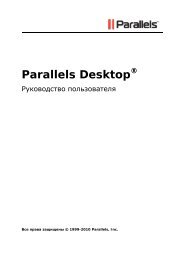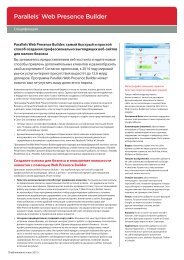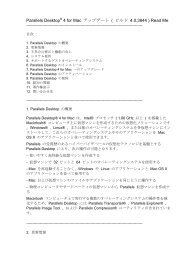[PDF] Parallels Server 5 Bare Metal
[PDF] Parallels Server 5 Bare Metal
[PDF] Parallels Server 5 Bare Metal
Create successful ePaper yourself
Turn your PDF publications into a flip-book with our unique Google optimized e-Paper software.
Viewing Active Processes and Services<br />
Managing Services and Processes<br />
The vzps utility provides certain additional functionality related to monitoring separate Containers<br />
running on the <strong>Parallels</strong> server. For example, you can use the -E switch with the vzps utility to:<br />
• display the Container IDs where the processes are running<br />
• view the processes running inside a particular Container<br />
vzps prints the information about active processes on your <strong>Parallels</strong> server. When run without any<br />
options, vzps lists only those processes that are running on the current terminal. Below is an<br />
example output of the vzps run:<br />
$ vzps<br />
PID TTY TIME CMD<br />
4684 pts/1 00:00:00 bash<br />
27107 pts/1 00:00:00 vzps<br />
Currently, the only processes assigned to the user/terminal are the bash shell and the vzps<br />
command itself. In the output, the PID (Process ID), TTY, TIME, and CMD fields are contained. TTY<br />
denotes which terminal the process is running on, TIME shows how much CPU time the process<br />
has used, and CMD is the name of the command that started the process.<br />
Note: The IDs of the processes running inside Containers and displayed by running the vzps command<br />
on the <strong>Parallels</strong> server does not coincide with the IDs of the same processes shown by running the ps<br />
command inside these Containers.<br />
As you can see, the standard vzps command just lists the basics. To get more details about the<br />
processes running on your server, you will need to pass some command line arguments to vzps.<br />
For example, using the aux arguments with this command displays processes started by other<br />
users (a), processes with no terminal or one different from yours (x), the user who started the<br />
process and when it began (u). Besides, you can pass vzps the -E switch to sort the processes<br />
by the Container IDs where they are running.<br />
# vzps aux -E<br />
USER PID %CPU %MEM VSZ RSS TTY STAT START TIME COMMAND<br />
root 1 0.0 0.0 1516 128 ? S Jul14 0:37 init<br />
root 5 0.0 0.0 0 0 ? S Jul14 0:03 [ubstatd]<br />
root 6 0.0 0.0 0 0 ? S Jul14 3:20 [kswapd]<br />
#27 7 0.0 0.0 0 0 ? S Jul14 0:00 [bdflush]<br />
root 9 0.0 0.0 0 0 ? S Jul14 0:00 [kinoded]<br />
root 1574 0.0 0.1 218 140 pts/4 S 09:30 0:00 -bash<br />
There is a lot more information now. The fields USER, %CPU, %MEM, VSZ, RSS, STAT, and<br />
START have been added. Let us take a quick look at what they tell us.<br />
The USER field shows you which user initiated the command. Many processes begin at system<br />
start time and often list root or some system account as the USER. Other processes are, of course,<br />
run by individuals.<br />
159


![[PDF] Parallels Server 5 Bare Metal](https://img.yumpu.com/18850617/159/500x640/pdf-parallels-server-5-bare-metal.jpg)
![[PDF] Parallels Desktop® 7](https://img.yumpu.com/18852044/1/190x245/pdf-parallels-desktopr-7.jpg?quality=85)

![[PDF] Parallels Python API Reference](https://img.yumpu.com/18850615/1/190x245/pdf-parallels-python-api-reference.jpg?quality=85)








![[PDF] Parallels Python API Reference](https://img.yumpu.com/18850529/1/190x245/pdf-parallels-python-api-reference.jpg?quality=85)

